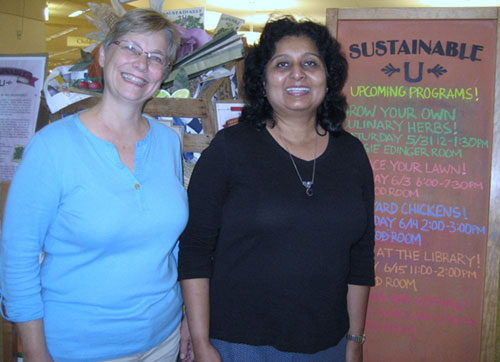
California is in the midst of a drought, and Santa Clara water rates are going up in July. It’s the perfect time to replace your thirsty, ho-hum lawn with beautiful, drought-tolerant California native plants. But where and how do you begin?
“Native Plants As Lawn Alternatives or, How To Liberate Your Creativity,” a 90-minute talk June 3 at Santa Clara’s Central Park Library, provided rationale, inspiration, and know-how. Radhika Thekkath, an executive board member of the California Native Plant Society, Santa Clara Valley Chapter (CNPS-SCV), pointed the way to taking what may seem a bold landscaping leap.
“It’s time to free yourself of the boxy lawn that you have lived with for years. Do it creatively,” says Thekkath, who transformed her own traditional Palo Alto front and back yards into an oasis of colorful native plants. She shared the process—from getting started and landscape design to planting and maintenance—with the approximately 30 attendees at the evening presentation.
To take advantage of the Santa Clara Valley Water District’s Landscape Conversion Rebate (www.valleywater.org), you must submit an application, set up an inspection of your existing lawn, and be approved before beginning your landscaping project.
Rather than remove sod, Thekkath used sheet composting on her lawn, covering it with five layers of newspaper, topping that with 1 1/2-inch mulch to a depth of about two inches, and dampening it once a week. Following this method, it takes four to eight weeks for the area to be ready for planting.
In creating a landscaping plan, design to full size, choosing plants whose mature size is appropriate for your yard without pruning. This means that the area will look sparse when first planted. In the meantime, scatter a handful of poppy seeds, for example, over the unplanted ground for a burst of color.
Choose one-gallon or smaller-sized plants. Studies have shown that the root system of this size plant establishes itself well and, over time, the smaller plants can outgrow the larger ones.
The CNPS-SCV recommends planting drought-tolerant native species rather than imported plants that are drought tolerant. The native plants are uniquely suited to the California ecosystem and best support native birds, butterflies, and insects.
“Ragged leaf edges are a strong indicator of a healthy environment. If the edges aren’t ragged, you’re not feeding the environment. Be tolerant of minor plant damage,” says Thekkath.
Resources for gardening with natives are on the CNPS-SCV website (www.cnps-scv.org) and on its interactive Gardening With Natives subgroup forum (http://groups.yahoo.com/group/gardeningwithnatives).
“Just take it a step at a time and get support by joining the Native Plant Society and the GWN forum,” advises CNPS-SCV member and volunteer Debbie Ballentine.
Santa Claran Chuck Harrington immediately followed her advice.
“I’m retired, and I joined to learn more,” he says. “I’ve never liked grass. It’s a waste of water.”
The native plant talk was sponsored through the library’s “Sustainable U” program, which also provides free seeds (located in a catalogue box on the second floor of the library) for patrons. Additionally, patrons can place and pick up weekly orders of locally-grown produce and sustainably-raised fish. Visit www.library.santaclara.gov for details.





